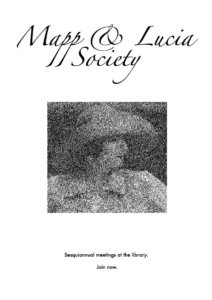Mapp and Lucia aficionados are clearly at an advantage here. This was part of a birthday treasure hunt for someone special: a poster hanging at the Barbican Library, and a transparency in a book at the Guildhall Gallery that, when overlapped, gave a cue.
A small academic cottage industry has improved methods for hiding information so that it is only revealed if innocuous-looking pictures are overlapped. Properly done visual cryptography can offer the strength of a one-time-pad and still be decoded by merely overlapping a pre-defined number of transparencies (or “shares”) with seemingly random or unrelated patterns.
No such pretensions here though, and a very simple method was used: I represented each grayscale pixel in the patent (i.e. obvious) images with a 2×2 black-and-white matrix. 0 – 1/4 – 1/2 – 3/4 – 4/4 of the matrix was black, depending on the darkness of the original pixel. When dithering an image this way, for middle tones there is a choice of different patterns with equal darkness. For example, there are six ways to set half the matrix black: ▚, ▞, ▌, ▐, ▀, ▄. Depending on the pattern combination, two overlapping 1/2 black matrices can be 1/2, 3/4, or 4/4 black:
▚ + ▚ = ▚ or ▀ + ▀ = ▀
▚ + ▌ = ▙ or ▀ + ▐ = ▜
▚ + ▞ = █ or ▀ + ▄ = █
and so on.
Generally a 2×2 matrix in the hidden image can represent any grey that is at least as dark as the most dark of the overlapping two matrices. Continue reading
![David Molnar [Update:, PhD]](https://www.srcf.ucam.org/~dm516/wp-content/themes/twentyeleven/images/headers/chessboard.jpg)

